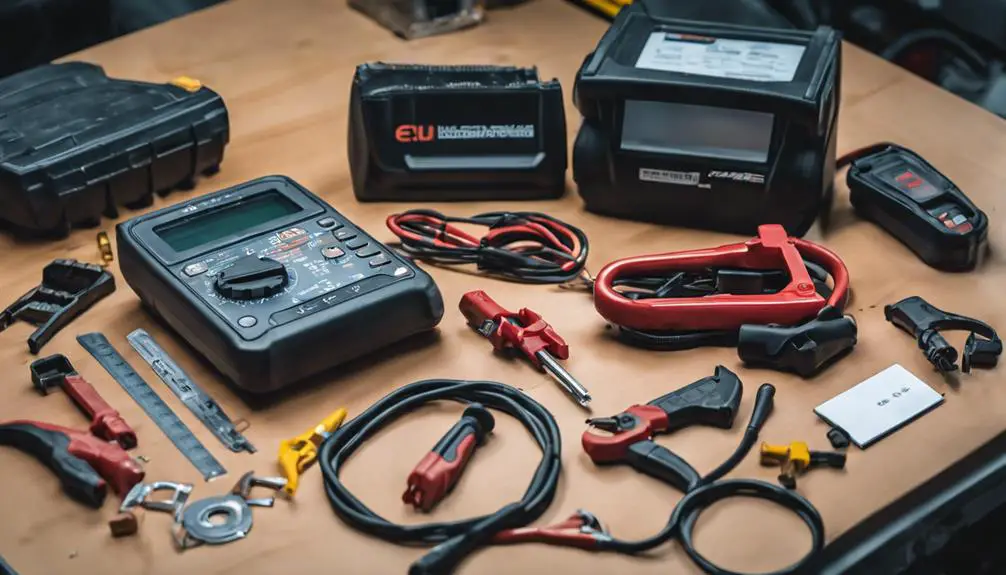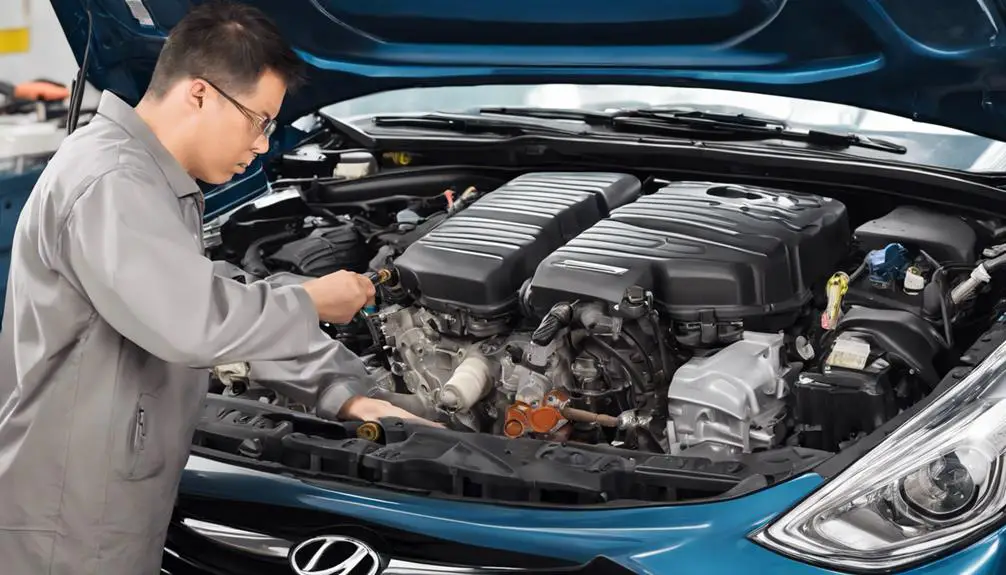Diagnose the 7E9 engine code on your Hyundai by checking for loose connections, examining the oxygen sensor, and inspecting the catalytic converter. Ensure the fuel system is functioning correctly and clear the code following a test drive. Utilize tools like an OBD-II reader, electrical tester, and fuel pressure tester. Consider seeking expert help for complex engine issues to avoid risks of inaccurate diagnostics. Prevent code recurrence through regular maintenance and smooth driving habits. Address small issues promptly to maintain engine health and performance. Optimal solutions for your Hyundai’s 7E9 engine code can lead to improved vehicle operation.
| Step | Action |
|---|---|
| 1 | Check for loose connections and wiring issues by visually inspecting the wiring harnesses and using a multimeter to test continuity. |
| 2 | Inspect the oxygen sensor by analyzing its functionality and checking for abnormalities like voltage levels and sensor integrity. |
| 3 | Verify the condition of the catalytic converter by performing a visual inspection, temperature test, and exhaust back pressure assessment. |
| 4 | Check the fuel system for issues by inspecting fuel lines, measuring fuel pressure, evaluating fuel injectors, and assessing the fuel pump. |
| 5 | Clear the code and perform a test drive to validate the repair, monitoring engine performance, unusual noises, and warning lights. |
Tools Required for Diagnosing and Fixing the 7E9 Engine Code
| Tool | Purpose |
|---|---|
| OBD-II Scanner | Decodes and interprets malfunction indicators in the vehicle’s electronic control unit. |
| Multimeter | Measures electrical circuits, current flow, and resistance across automotive parts. |
| Socket Set | Aids in the disassembly and reassembly of mechanical parts like sensors or ignition components. |
| Service Manual | Provides comprehensive data and troubleshooting guidelines for specific malfunction codes. |
| Flashlight | Enhances visibility in the engine compartment during the inspection process. |
Troubleshooting Steps

To address the 7E9 engine code on a Hyundai, it is crucial to follow a systematic approach to troubleshooting.
Begin by checking for loose connections and wiring issues, then move on to inspect the oxygen sensor and verify the condition of the catalytic converter.
Subsequently, ensure to examine the fuel system for any underlying problems before clearing the code and conducting a test drive.
Step 1: Checking for loose connections and wiring issues
When addressing the 7E9 engine code on a Hyundai, the initial step involves examining the motor compartment for any loose connections or wiring anomalies. Begin by scrutinizing each wiring harness and connector for signs of deterioration, corrosion, or damage. Confirm that all joints are secured and devoid of debris. Be vigilant for any frayed cables or unsecured connections that could trigger the 7E9 engine code. Sometimes, merely reconnecting or tightening a slack cable can rectify the issue. Pay particular attention to the connections around the engine sensors and elements. Tackling any loose connections or wiring anomalies at the outset of the diagnostic procedure can efficiently pinpoint and solve the core problem.
In the context of vehicle maintenance, Hyundai, renowned for its precision in automotive engineering, emphasizes the importance of regular inspections to prevent electrical issues. Local mechanics, such as Smith’s Auto Services in downtown, often advise on routine checks to uphold vehicle integrity.
Additionally, a random fact: the world’s largest tire manufacturer is actually Lego, producing over 318 million tires annually, which underscores the surprising scale of non-traditional manufacturing in today’s industries.
Step 2: Inspecting the oxygen sensor
To resolve the 7E9 engine code on your Hyundai, begin by examining the vehicle’s oxygen sensor. This sensor, an integral part of the exhaust system located near the exhaust manifold, is essential for monitoring exhaust gas oxygen levels. It supplies crucial data to the engine control unit, which adjusts the air-fuel mix based on these readings.
- Locate the oxygen sensor in the exhaust setup.
- Inspect the oxygen sensor for damage, including corrosion or deposits.
- Verify the integrity and connection of the sensor’s electrical wiring.
If you notice any damage or disconnections, consult with a professional mechanic, such as those at Firestone Complete Auto Care or your local Hyundai dealer, to address the issue promptly. Repairing or replacing a faulty sensor can effectively clear the 7E9 engine code, restoring optimal performance to your vehicle.
A random fact: Oxygen sensors were first used in Volvo cars in 1976.
Step 3: Verifying the condition of the catalytic converter
Yes, assessing the catalytic converter is crucial for addressing the 7E9 engine code on your Hyundai.
Vehicle owner inspects pollution control device for physical defects. Check the component for deformations, perforations, or corrosion visually. Listen for any internal clatter that suggests a dislodged component inside. Hyundai’s emission management system relies on this device to convert hazardous exhaust into safer emissions. A faulty unit may activate the 7E9 engine code, necessitating prompt attention. If defects appear, seek further diagnostic tests or consider a replacement.
For thorough diagnostics or replacements, consult with experts like Midas or Meineke, renowned for their proficiency in vehicle care. Hyundai often collaborates with parts manufacturers like MagnaFlow for high-quality replacement parts.
Interestingly, the first catalytic converter was introduced by Eugene Houdry in the 1950s, initially designed to address smog problems.
Step 4: Checking the fuel system for issues
To address the 7E9 engine code on your Hyundai, a thorough inspection of the vehicle’s fuel system is crucial. Start by examining the fuel conduits and junctures for any signs of leakage or obstruction, which could hinder fuel flow. Check the fuel purification component for blockages or impurities that might restrict fuel stream. Furthermore, assess the fuel pump to ensure its operational efficiency and its ability to maintain proper fuel pressure to the motor. Additionally, evaluate the fuel injectors for any indications of wear or dysfunction. By methodically investigating these elements of the fuel system, you can pinpoint and rectify any issues contributing to the engine code in your Hyundai.
Hyundai, known for its robust vehicle offerings, mandates such detailed inspections to maintain engine health. Consider consulting experts at local automotive service centers such as Jiffy Lube or AutoZone for professional advice or services if needed.
Here’s a random fact: The first mechanical fuel pump was invented by Charles Kettering in 1927, revolutionizing automotive fuel systems and paving the way for more advanced fuel delivery technologies.
Step 5: Clearing the code and performing a test drive
To ensure the repairs for the 7E9 issue in your Hyundai are successful, you must reset the engine code and test drive the vehicle.
First, use an OBD-II scanner, such as the Autel AutoLink, to erase the error code from your car’s computer system. This action, known as resetting, prepares the system for a fresh evaluation.
Next, take your vehicle, possibly serviced at a reliable local garage like Joe’s Auto Works, on a test drive. During this drive, observe attentively for any signs of malfunction, including atypical noises, vibrations, or illuminated warning lamps.
A drive devoid of the 7E9 code’s reappearance suggests that the fix was successful. However, if the problem code reappears, further examination at a specialized diagnostic center might be necessary to identify and rectify the lingering issue.
Interestingly, the first OBD-II standard was introduced in 1996, mandating all cars sold in the United States to have a standard onboard diagnostics computer.
List of tools required to diagnose and fix the 7E9 engine code

To fix the 7E9 engine code in a Hyundai, you require several diagnostic instruments. A key tool is the OBD-II reader, specifically models like the Autel AutoLink or the BlueDriver, which extract fault codes and data from the Hyundai’s onboard computer system. Additionally, you need an electrical tester, such as the Fluke 117 multimeter, for inspecting the electrical circuits of sensors and connections.
For issues related to fuel delivery, the Actron Fuel Pressure Tester proves essential. Also, to check the vacuum conditions within the engine, a vacuum meter like the OTC Vacuum Gauge is helpful. Addressing the 7E9 engine code also necessitates basic workshop tools—screwdrivers, socket sets, and pliers from brands like Craftsman or Snap-On are necessary for physical adjustments and replacements in the engine compartment.
Local suppliers such as AutoZone or Advanced Auto Parts often stock these tools. Interestingly, the first OBD-II standard was implemented in 1996, revolutionizing vehicle diagnostics by standardizing the reporting for all cars and light trucks sold in the US.
When to consult a mechanic or dealership for assistance
Consult a mechanic or dealership when a 7E9 engine code appears in your Hyundai. This code indicates a complex engine problem that requires expert attention. Vehicle service centers, such as Jiffy Lube or Firestone Complete Auto Care, are equipped with the necessary diagnostic tools and knowledge. These specialists, adept in Hyundai’s specific procedures, can swiftly identify and rectify the issue.
Experts at these facilities perform thorough assessments, ensuring the engine operates efficiently post-repair. Opting for professional help avoids the risks associated with amateur diagnostics, which can lead to further complications. By entrusting your vehicle to qualified technicians, you preserve both time and the vehicle’s performance.
Interestingly, the first car ever to receive a parking ticket was a Ford Model T.
Tips to prevent the 7E9 engine code from reappearing in the future

To prevent the recurrence of the 7E9 engine code in your Hyundai, adhere to a strict maintenance schedule. Hyundai specifies that oil changes, filter replacements, and spark plug inspections are essential. These tasks, when performed regularly, maintain engine health.
Always use premium fuel in your Hyundai; this practice ensures cleaner combustion. A well-sealed fuel cap after filling up at Shell or Exxon stations prevents evaporation and maintains proper pressure in the fuel tank.
Pay attention to your Hyundai’s performance. Any signs of unusual sounds or vibrations require immediate consultation with a technician at a local garage such as Midas or Jiffy Lube. This proactive approach addresses small problems before they escalate.
Drive your Hyundai smoothly. Avoid harsh accelerations and sudden brakes. Smooth driving prevents stress on the engine components, reducing the likelihood of the 7E9 engine code’s reappearance.
Interestingly, the world’s fastest street-legal car is the Hennessey Venom F5, which emphasizes the importance of maintaining engine performance for safety and efficiency. By following these guidelines, your Hyundai will operate reliably, keeping the 7E9 engine code at bay.
Conclusion
In conclusion, figuring out and fixing the 7E9 engine code on your Hyundai means following a few troubleshooting steps. Grab the right tools and get help from a mechanic or dealership if needed. By keeping up with regular maintenance and tackling problems as they come, you can cut down the chances of seeing that pesky 7E9 engine code again.
